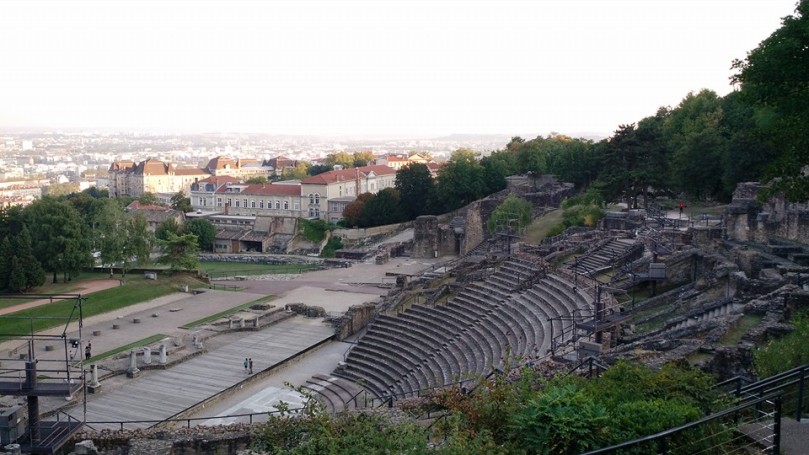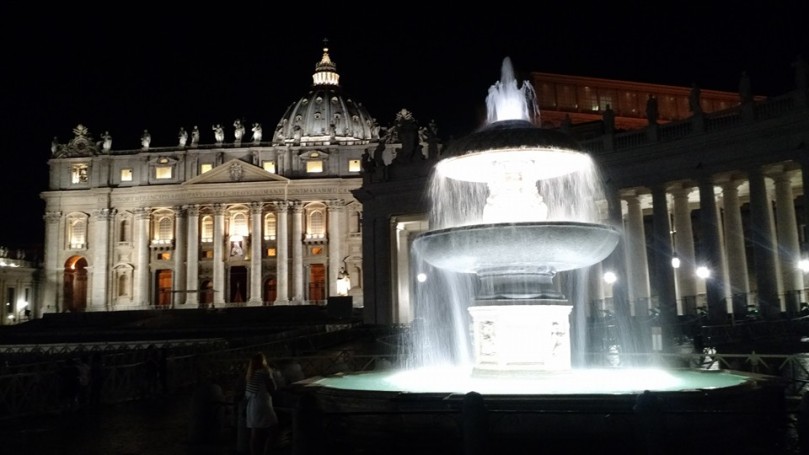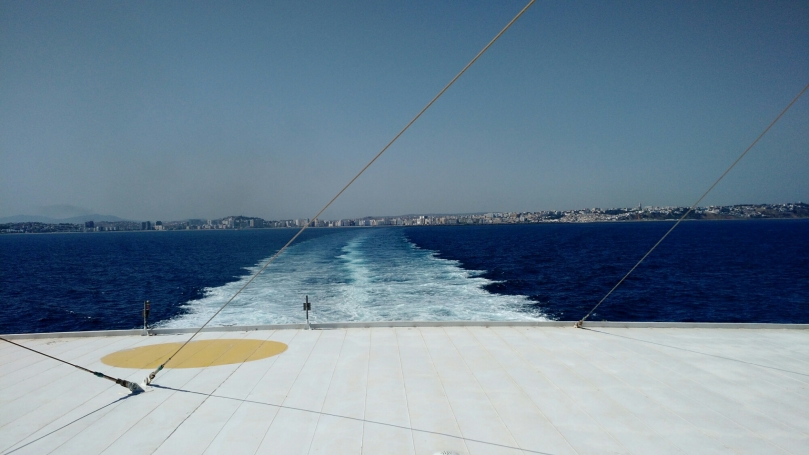
After a cafe breakfast of cappuccinos and croissants, Josh and I said goodbyes and I took the tram to the Geneva airport, where my Swiss Blablacar driver drove me into France, to Lyon. She was from Lausanne, of Algerian descent, and spoke French, and today she was driving to Lyon to do some shopping. An hour or two later I was exiting a big, generic French mall and walking with my backpack and banjo on the streets of Lyon, looking for my Couchsurfing host’s address.
I had already made arrangements to be hosted in Lyon for a couple nights and Paris for a few more, but it was only after making these arrangements that I discovered a new function of the Couchsurfing site/app that I should have been using all along – instead of sending requests directly to potential hosts, you can just post a public notice of your trip and let hosts contact you. I didn’t think people would respond, but while waiting for the hosts I’d messaged to respond, I posted one in Lyon to test it out. I ended up getting a couple of offers from fellow musicians, although by then I’d already found a host. We arranged to hang out instead. I had social plans!
Olga, my host, was working from home that day, so I met her at her apartment. She’s a Polish woman who’s lived in Lyon for around a decade and loves it. Her interestingly accented English is excellent, and I’d hardly been there ten minutes before she was asking pointed questions about my deepest motivations and philosophies. She’s an intense person, and if you give an answer she doesn’t like she’ll challenge it. We talked about travel and cultures and the direction of the world while she cooked us a little vegan lunch, thinly sliced, exotically spiced, sauteed zucchini and other vegetables. And then she was off on business and I was off exploring.
Knowing nothing of Lyon except for the high quality of its food, I wandered for hours, crossing a river into the main part of the city. Like Pittsburgh, Lyon is built in the crook of two merging rivers, filling up its peninsular center and spilling out across the waters on both sides. Cool shops and parks fill the middle bit. After snacking and popping into a couple music shops, I crossed the second river and took the inclined rail up the hill to the cathedral. Cathédrale Saint-Jean-Baptiste. The church itself is a blocky, white Gothic thing. It was closing for the evening when I arrived, so I walked around the side, noticing an old priest talking kindly to some tourists in the shadow of a statue of priest who looked exactly like him. Beside the cathedral is a lookout point where tourists crowded up to the railing to see the whole city spread out beneath in the peach-colored twilight.
Down the hill lay the ruins of a massive Roman amphitheater. The taller bits are crumbling, but the amphitheater itself, stage and stairs and rows and rows of seats built into the hill, is startlingly intact, untouched. Despite other tourists and a small pack of teenagers quietly milling around, I felt quite alone, surveying the ancient view in solitude. It was silent and a bit surreal. At the bottom, behind the stage, there are rows of big stone slabs with Latin inscriptions, moved out of the way and clustered together, evidently not worth putting in a museum. They looked ancient, but they were just sitting there heavily, where anyone could look at or sit on them. It’s amazing they weren’t covered in graffiti.

I finally got a hold of Sarah, the Couchsurfer I was going to hang out with that evening. We were going to grab some food, but her texting was frustratingly intermittent. She was going to meet me in twenty minutes, so I set up to busk on a cool, narrow, pedestrian street full of restaurants and neat shops. An hour and a half later, grumpily walking back towards Olga’s, little tummy rumbling up a storm, I finally heard back from her again – apparently she’d had another international visitor who needed some guidance on his way out of town, and she hadn’t thought to tell me. I decided to get over it, and we met up in the main part of Lyon and got dinner at a fun little creperie. Now, crepes are all over Europe, one of the dominant street foods in any mainland European city. But this was my first French one and my first sit-down one, so my expectations were high. Well, it was delicious. I had a meaty salad with morally questionable foie gras in it (seemed appropriate), then a tasty little savory crepe with goat cheese and whatever the French version of bacon and eggs is called, and finally a dessert crepe loaded with nutella and some ice cream.
All the while Sarah told me about her life, with all the innocent self-absorption of an enthusiastic college-aged creative type. She’s a Frenchwoman of North African descent, working in event organization, if I’m remembering right. She’s gotten to meet a whole bunch of celebrities that way, which she loves talking about (she’s since moved back to Paris to be in the middle of the action again). For her, the main perk of the job is exposure, as she’s also an aspiring singer with a decently popular YouTube channel. Covers are her main thing, and because our methods of performance and creation are pretty different (I’m more about the writing, and performance is just something I fumble through), I couldn’t relate much to her experience, but it was fascinating to hear her opinions on things. She’s just starting out, but she’s not taking the grassroots, word-of-mouth route like me. Her strategy is to be seen online as much as possible and rub shoulders with influential people through her work, all with the intent of getting swept up into the rapid pop-music current. And heck, she’s hung out with Katy Perry through her job, so maybe she’ll do it.
The next day, after walking across town and having a fancy croque monsieur (which apparently translates to “gentleman crunch?!”), I tried my hand again at busking. The cool little area under the cathedral had been great in the evening, but the daytime audiences were standoffish, so I went to the main shopping street. I had better luck there for a little while, but I kept being told to move – by a mall employee, then by a squad of police – so I gave it up around when my second Couchsurfing pal was ready to hang out. Damien met me there with his guitar, and we made our introductions, bought some beer, and headed down to the riverwalk to jam.
The benches down by the river are really the perfect place for an outdoor jam session. Dogwalkers and families strolled by lazily like flotsam in the river beneath them while we told each other our stories through songs we’d written and favorite covers. We swapped instruments a bit; I’d missed playing guitar, and everyone likes trying out a banjo. Music is a great language to have in common, but Damien had great English, too (as did Sarah). Maybe it’s because people in the Couchsurfing community tend to be globally minded, but I was having great luck finding French people who didn’t mind speaking English with me. Besides that, Damien had consumed as much American media as the rest of the western world, so we knew a lot of the same music, and we bonded quickly over our mutual love for Adventure Time. Later we grabbed falafel and went back to the apartment he shares with his brother, where we played with the instruments he had lying around for a while. Then Damien’s older brother dropped by, and we all talked about Star Wars while drinking Pastis, a spirit popular in southeastern France that’s served diluted with water and basically tastes like boozy licorice.
Damien is my kind of dude, and I sincerely hope we hang out again. It’s true that Lyon had delicious food and a nice vibe, but my favorite thing about it was the new pals. To anyone planning some Couchsurfing travel, I recommend posting your trip publicly and seeing who offers to host you. Generous people will appear.















 Rimini: Italy’s Florida?
Rimini: Italy’s Florida?







 My budget and the late hour kept us from riding all the rides, but we made sure to hop onto the big carousel before we left. I think that’s the biggest smile I’ve seen on Jane’s face to date.
My budget and the late hour kept us from riding all the rides, but we made sure to hop onto the big carousel before we left. I think that’s the biggest smile I’ve seen on Jane’s face to date.




